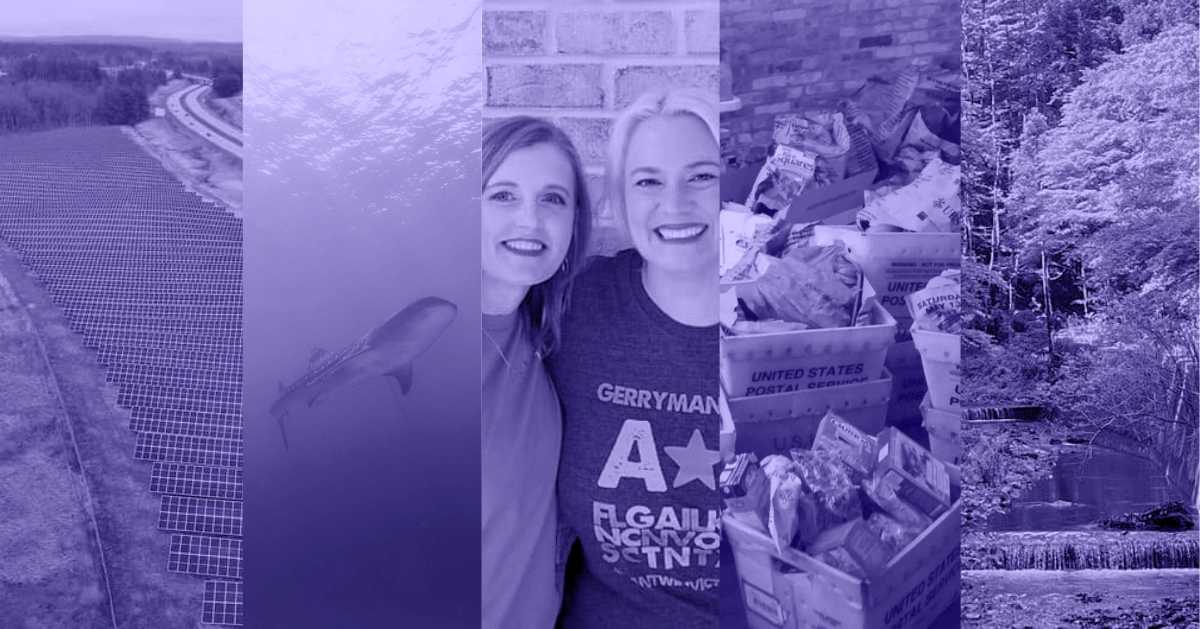This waste, combined with the challenging financial position coffee farmers face every day, creates an urgent need for sustainable solutions that can alleviate both climate concerns and the economic well-being of farmers.
While most coffee drinkers think of coffee grounds as the primary by-product of their morning cup of coffee, another sweet-tasting coffee by-product could be the key to helping people, profits, and the planet: cascara.

Cascara — which means “husk” in Spanish — is the skin and fruity pulp of the coffee fruit (often called the coffee cherry or coffee berry) and offers great potential to decrease the industry’s carbon footprint while providing value to consumers via upcycled food products.
What’s better is it presents the potential for farmers to generate additional revenue streams, decrease costs, and improve crop yields.
As world-wide coffee production continues to increase to meet a growing demand, so do the environmentally harmful by-products of the coffee supply chain. If best practices are widely adopted, there is an opportunity for the coffee industry to become a leader in carbon-neutral, zero-waste practices.
What is cascara?
While most people are familiar with coffee, it’s a lesser-known fact that coffee beans are actually the seed of a fruit called a coffee berry.
The berry itself contains caffeine (that’s how coffee gets its caffeine!) and is high in antioxidants. As coffee beans grow, the fruit protects them by deterring insects and other wildlife that could prevent the development of the seed.

Cascara is usually thrown away — contributing to food waste — but it can instead be dried and brewed as a “tea,” served either hot or cold.
Similar drinks have long been brewed in Yemen and Ethiopia, the birthplace of coffee culture, where they are called quishr or hashara.
Although it comes from the coffee plant, cascara tastes nothing like coffee. It has a sweet, fruity, cherry-like flavor, most closely resembling an herbal tea. The taste of coffee berry tea can also depend on where it’s grown and how it’s handled, dried, and brewed.
Cascara is composted and used as fertilizer or biofuel about 30% of the time. The other 70% of cascara is thrown away.
According to Paul Evers, the CEO and co-founder of Riff, oftentimes, cascara is composted and used as a converted fertilizer or biofuel. This only happens about 30 percent of the time, Evers said, and the other 70 percent of cascara is thrown away.
“Very little of it is translated into a consumable food product,” Evers said. “By upcycling it and translating it into a food or beverage that appeals to a mass audience and working with our peers, we can hopefully expedite the building of this separate category and generate greater demand.”
When Riff began looking into this cascara-based beverage development, Evers said it was important to “operate with integrity” and reached out to Oregon State University environmental scientist Christina Schlachter, Ph.D. to help conduct research on the opportunities available for cascara and carbon neutral coffee production.
What came from this research was a full report on cascara and the coffee industry: “Solving Coffee’s Not So Little Dirty Secret: Opportunities for Upcycling and Recycling Coffee Fruit.”
"I think it’s really important in saying it’s cascara not just a byproduct; it actually has a tremendous amount of value."
“I think it’s really important in saying it’s [cascara] not just a byproduct; it actually has a tremendous amount of value,” Schlachter said. “So if we can capture that percentage of cascara that is food grade and use the other percent for biogas, or fertilizer, or compost for future crops, that would be an ideal situation.”
Riff is just one company aiming to do this. Even Starbucks has gotten in on the cascara trend, introducing a cascara latte and cold brew to the menu.
“We’re saving it [cascara] from going to waste and decomposing, contributing to greenhouse gas emissions, by injecting greater economic value into it,” Evers said. “It’s helping to potentially double revenue streams and employment for struggling farming communities, helping reverse coffee’s contribution to climate change, and also helping introduce greater sustainability for the industry itself.”
How could cascara change the world? — Here are 5 ways it can:
1. By stopping nutrient-rich food from going to waste, helping to curb climate change
In the 2018–2019 season alone, the coffee industry harvested 120 billion pounds of coffee berries, leaving nearly 100 billion pounds of by-product in the process, 58 percent of which was cascara. If not upcycled or recycled correctly, that 58 billion pounds could emit 14.2 million metric tons of CO2, which is equivalent to 35 billion miles driven by a car — enough to circle the globe almost 1.4 million times.
Some cascara is composted, but much of it is discarded into landfills or waterways, harming water quality and decreasing biodiversity.
“We know that not all cascara that’s created is food grade,” Schlachter said, emphasizing the importance of using cascara in creative ways so it’s “not just sitting there going unused, and in some situations, going into waterways, which means there’s too much organic material in the water, which can actually kill living animals in water sources.”
The use of cascara fruit presents a unique opportunity for upcycling to create biofuels, feedstock for animals, and even food products.
2. By benefiting independent smallholder farmers who need a reliable living
According to the International Coffee Council, over 100 million households depend on coffee for their livelihood, and almost 80 percent of global production is in developing countries on smallholder farms (farms that are less than five acres in size).
The coffee industry has a unique opportunity to become both carbon-neutral and zero-waste with proper investment and upcycling. This greatly benefits smallholder farmers, who, if the cascara market continues to scale, would increase revenue without needing to harvest extra product.

Smallholder farmers have limited resources to invest in new technology or machinery to update their practices, but a solution is to identify ways to minimize the impact of coffee by-products on the environment while increasing revenue and coffee yields for farmers. Enter: cascara.
Maximizing use of cascara presents this opportunity to turn waste into revenue. By creating a mass market for cascara, farmers can increase revenue with little expense, as the “waste” pays $.03 per pound.
“You could have a circular economy,” Schlachter said. “We're using the coffee fruit, we're putting money into the coffee farmers pockets. They're able to use the waste again more efficiently.”
3. By saving the coffee industry
“Ironically, [the coffee industry] is contributing to its greatest threat,” Evers said.
As the climate grows warmer, farmlands are at great risk of becoming unproductive, with an estimated 43 percent of the land becoming unfarmable by 2050. Ironically, the coffee industry is contributing to its greatest threat by creating greenhouse gas emissions through food waste.
As coffee consumption increases, there are two primary ways to meet demand: Convert more land for agricultural use, or increase yields of the coffee fruit.
Coffee-producing countries already face the risk of losing productive farmlands due to climate change. The option of converting more land for agricultural use is not an option, as converting forested lands into coffee farms adds greater stress on the environment by limiting the ability to capture carbon.
Increasing coffee yields through more sustainable farming practices is the only feasible path to meet the growing demand sustainably.
4. By providing a nutritious product for consumers
The coffee bean only makes up 20 percent of the weight of the coffee fruit when it is picked from the tree. But the “waste” is fruit rich in nutrients.
In its raw state, cascara is high in soluble dietary fiber, plant-based proteins, and antioxidants. Studies have found initial indications that the coffee fruit extract could help improve the immune system and improve brain function.
100g of cascara fruit contains 50 percent of the recommended daily intake of Biotin and Vitamin E, 35g of fiber, and 6.15g of protein, with less than 1g of fat. For consumers who are caffeine-intolerant, the fruit’s caffeine levels are about one-third that of coffee.
Products currently on the market include drinks and teas, flour containing dried portions of coffee cherries, chocolate, and energy bars.
“If you gave me the chance of drinking something that was processed or created from some other type of material, versus something that was organic, as an energy drink? Yeah, of course I’m going to have something that’s more organic and healthier, and helps the planet,” Schlachter said.
Riff sells a cascara-powered energy drink that you can buy online, you can buy cascara liqueur from Whiskey Caviar, and places like Valiant Coffee, Huskwell, and Lady Falcon Coffee Club sell cascara teas. Like we mentioned earlier, Starbucks even sells a cascara latte.
“I think a lot of it is educating people,” Schlachter said. “You can ask the average person in line for coffee how coffee is made and I’m pretty certain very few will know exactly the process. The education is that this product is available and there can definitely be a bigger market for it.”
5. By bringing innovation to the coffee industry and its devoted consumers
Whether it was the unicorn frappuccino or the illustrious pumpkin spice latte, American coffee drinkers are typically inclined to try something new for their daily grind. Cascara invites innovation into the drive-thru — this time, without the price of the planet.
“Over time, coffee became a part of the American daily routine,” Evers said. “Our familiarity with it was a robusta coffee that was poured into a white ceramic cup at a diner. So it’s deeply entrenched, our idea of what coffee was, and what people don’t know, because there’s never been any real exposure to it.”
It all starts with demand. If brands can create cascara products that consumers love, demand for cascara will increase, which increases revenue for farmers and can divert waste, minimizing food waste and curtailing the effects of climate change, which will help the coffee industry continue to thrive for decades.
With cascara, Evers hopes Americans develop a greater appreciation for the whole coffee fruit.
“We're solving multiple problems,” Evers said. “We're translating a nutrient-rich agricultural product to products for the benefit of humans.”

Frequently Asked Questions
How much caffeine is in cascara?
Cascara tea has around 25mg of caffeine per cup (compared to 80mg of caffeine per cup of coffee), no matter how long the steeping time is. Compared to black tea which rests at around 50mg of caffeine per cup, cascara compares best with green tea which also has around 25mg of caffeine per cup.
Is cascara banned?
For many years, Cascara was considered in Europe as a “novel” food. A 1997 EU law states that any “novel” food — that is, one that hadn’t already been widely consumed in the EU before the law came into effect — must be proven safe before it can be sold.
In other words, cascara was not officially legalized in Europe but neither prohibited. In June 2021, The European Food Safety Authority delivered a long technical report to the European Commission that paved the way for cascara beverages to be sold in the EU starting in September 2021.
There aren’t any regulations on cascara in the U.S.
How is cascara made?
Cascara is made using the peel or husk of the coffee fruit. After the coffee seeds are removed, the berry (which is high in antioxidants) can be used in food-grade cascara products, or in fertilizers or biogas.
Cascara is often sold as a dried product to be made similarly to tea, brewed using boiling water. Similar to different kinds of coffee beans, cascara has different flavor notes with an underlying taste, which Evers called “a citrus lemony tartness.”






